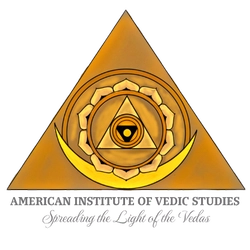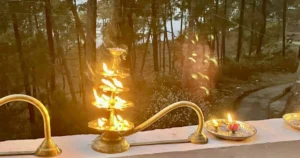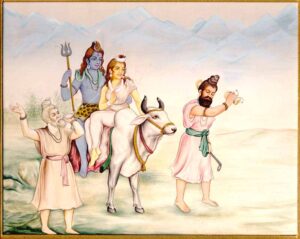The following article is authored by Pavan Kanwar, an advanced student of Vamadeva. He can be reached at [email protected] and even has a Website.
One of the important images of the Rig Veda is Agni (the sacred fire) as the guide leading us to immorality (Amrita) through the sacrifice of Soma or the mystic nectar to the Gods. The light of Agni shows us the way to Amrita as bliss and immortality, if we attract ourselves (Soma sacrifice) to the higher aspects (Gods) of our nature. This can be seen to have notable and wide-ranging implications.
Agni is literally the first word written in the Vedas, and possibly anywhere. It is given this importance because it has an important cosmic function at many levels. Agni can be said to represent the ‘metabolism of the universe’, and in this sense represents and causes all changes and becomes a guiding light. Similarly Soma is also considered to be of prime importance due to the complementary functions that it represents. Soma stands for all that nourishes and sustains, and thus provides comfort and enjoyment in the cosmos at all levels. In fact, Soma sustains the entire cosmos itself in its highest level (known as the cosmic waters), and thus space or Akasha, the first great element of manifestation according to Vedic thought, is said to be born of it. In this way, Soma is the fuel that sustains the light of Agni. The higher Somas, however, are fuels inherent in light and consciousness, not external substances.
Vedic science considers manifestation to occur across seven planes of existence, and we can trace the varying functions of Agni and Soma across these. At the lowest plane which represents the gross physical, Agni can be noted by its negation, i.e. a state of lack of change, inertia or darkness. At the next plane of Prana (forces and energy), Agni becomes fire along with its two associated properties of heat and light. In simple chemistry we can see that heat is necessary to cause change and metabolic activity. This form of Agni obviously also has important implications for the physical plane. The next plane is that of the outer mind and emotions, and here Agni corresponds to our will power in the sense that it gives us the discipline to change. This is known as Tejas in it lower function, and at all of these three planes Agni also correspond to Pitta dosha, the biological fire humor.
At the fourth plane of the inner mind and intelligence, Agni becomes subtle light and heat which brings about change by giving us a corresponding subtle vision. In its simpler form, Agni changes or rearranges information and represent logic or analysis. In its higher form it becomes illumination or revelation and relates to our higher perceptions. Here Agni is known as Tejas (or Jyoti) in its higher function. At the even higher planes which correspond to our eternal nature, Agni becomes pure consciousness or Chit itself, which has a causative power to create the entire universe.
Soma at the lowest plane becomes the total absence of any nourishment or sustenance, which is associated with the quality of dryness. At the next plane, Soma becomes water which holds Prana and is necessary for sustaining the physical. At the plane of emotions it becomes that which provides sustenance to the field of emotions, or the sea of the emotions. These three planes connect to Kapha dosha or the biological water humor from an Ayurvedic perspective.
At the fourth plane of intelligence Soma relates to Ojas, the inner power of endurance, and becomes that which provides the fuel or nourishment for our perceptions. At the higher and more eternal planes Soma connects to Ananda, the sustainer of all and thus a state of pure comfort or bliss.
Looking at these two forces from a conventional Ayurvedic perspective, we have Agni on the physical plane representing the quality of heat when in excess, and the quality of cold when deficient. Soma is nourishing in quality which is associated with water, and on the physical plane excess Soma leads to the quality of wetness, and deficient Soma leads to the quality of dryness. This allows for four combinations of Agni and Soma according to their hot/cold and wet/dry properties. Firstly there is cold and dry which is associated with Vata. Then there is hot and wet associated with Pitta, and there is also cold and wet associated with Kapha. These three are not necessarily disease causing states on their own but only when out of balance.
The fourth state is hot and dry which leads to Jvara or fever in the broadest sense of the term, and disease generally, in Ayurveda. Jvara is created when the three doshas are not correctly formed, and is therefore seen as the starting point for all diseases. The nature and extent of the disease depends on the existing nature of the doshas, dhatus (body tissues) and srotas (channels of flow) in which this state manifests, as briefly examined below.
When this fourth state combines with Pitta, the hot and dry conditions cause Pitta to increase in the digestive system creating a hot and a little wetter environment. This is appropriate for diseases of a more infectious in nature, or Pitta toxins (Ama). Eventually, even disease needs some wetness to manifest in the water dominated physical body, despite having a hot and dry origin.
When this fourth state combines with Kapha, it serves to melt (and only slightly dry) Kapha and increase it in the digestion, causing a cold and wet environment, which is suitable for Ama (toxins) and Kapha disease. When this fourth state combines with Vata, its dryness will tend to slow the flow in the channels (srotas) causing wet and cold pockets to manifest erratically, which is suitable for the manifestation of Ama (toxins). In this case, it depletes the already low water content in the body further, and therefore it becomes the most dangerous combination for disease due to the low water content (low sustenance), and the erratic nature of Vata dosha. It should be noted that it is possible for disease to progress with only a little Ama, or Ama to manifest without the proper onset of an acute disease. This depends on individual circumstances, including the nature of the doshas and lifestyle.
Apart from the above initial conditions, the strength of the disease depends on how far the doshas enter (or are allowed to enter via poor life-style habits) the body in terms of the dhatus. When only in the outer tissues of blood and plasma, a disease is relatively easy to treat. When it reaches the bones, and especially when combined with a predominance of Vata, we typically see arthritic conditions. Additionally, when the manovaha srotas (mental channels) gets blocked, the mind and Prana become stagnant. This can lead to cancer, particularly when combined with a Vata dosha environment again.
Generally, treatment of the formation of Ama (toxic undigested food) which requires wetness to exist, is a purer form of hot and dry than causing toxic hot and dry conditions. The body’s internal response itself produces this to a certain extent as a fever, which is a stage of Jvara. It is purer as it generated by the displacement of the digestive Agni by the doshas (to the level of the plasma and blood initially), and this Agni is basically formed in harmony with nature for the process of digestion. The disease causing hot and dry is usually formed in violation of nature, e.g. due to bad life-style. This purer hot and dry can be aided by adding appropriate non-toxic hot and dry qualities (relating more to Tejas and Prana, and referred to later in the article) at the appropriate times in the form of treatments, bearing in mind the dosha environment.
Now taking a look at the above Rig Vedic sacrifice again, we can see on the spiritual plane Amrita (immortality) is achieved via Agni (hot) and a Soma sacrifice (dry). Thus we see that what is Amrita spiritually can correspond to Jvara (fever) on the lower planes, with Agni and Soma together assuming disease forming qualities at these levels. Generally, our current lifestyles have an excess of the lower form of Agni and its Rajasic quality, as evidenced by the over-activity and excess stimulation that is widely prevalent in our life-styles. Therefore it is not surprising that we currently have a thirst for the over-consumption of Soma as nourishing water (mainly of the lower form as white sugar, soft drinks etc.), to avoid the hot dry conditions of Jvara or internal heat and agitation.
However, if we follow the Rig Vedic imagery through, in order to avoid Jvara we need to sacrifice Soma (Vairagya or detachment) rather than consume it, which can lead to very different results. We need to give up the low level Soma for a higher level Soma to be able to manifest. As a fuel, deficient Soma or dryness can be seen to have different properties to sacrificed Soma. Vairagya, the giving up of the lower Soma, gives mastery due to independence, whereas deficiency, or lack of Soma, often implies dependency and therefore a state of being controlled.
With Vairagya we become detached or independent from disease (and death) causing factors, and connect to our higher, immortal and blissful aspects. It is an important factor in the transformation of Agni and Soma from their lower forms to their higher forms, and the corresponding transformation of Jvara into Amrita, and thus some of the meaning of the famous line from the Brihadaranyaka Upanishad can be seen: mrityormamritam gamaya (lead me from death to immortality or bliss). It is a movement from the lower heat, fever or Jvara of desire and disease to the higher Amrita or immortality of light and clarity.
In this way, sacrificed Soma has the power to raise the Agni from its lower and potentially disease causing state of excess heat, to a higher level (Tejas) that allows us to see Amrita or Ananda in all via its purified light (Viveka or discrimination). This is alchemy from the Ayurvedic perspective, where Pitta is transformed into Tejas, disease into health, matter into spirit and mortality into immortality. Similarly, via the Soma sacrifice, Vata has the potential to be transformed into pure Prana, and Kapha into pure Ojas.
When we look at certain Yoga practices involving Kundalini and Tantra we can see that they deal specifically with concepts such as Agni and Soma, with Agni corresponding to the Kundalini Shakti at the base of the spine, and Soma to the crown chakra. However we have also seen that if the concept of detachment is not present, these practices can lead to disease, as they can generate the lower forms of Agni by stimulating the Kundalini at the base of the spine but not being able to raise it up. This Agni on its own is hot and dry, and thus represents the basis for the onset of disease and depletion. Here the world of doshas and Jvara (fever) begin to dominate, and the alchemical power to lift Agni and Soma into their more natural and higher domains is reduced.
It is interesting to compare the disease potential of different Yogic practices, particularly what is commonly known as the left and right handed Tantric practices. The left handed practices work on the principle of generating Agni as Tejas feeding of the fuel of detached contentment (sacrificed Soma) present in the physical world. The intention is to transcend material pleasure. However, without the Soma sacrifice, we are left with toxic Agni as it burns on a low quality fuel of attraction to materiality (consumed Soma), and this typically leads to a toxic hot and dry environment. The right handed Tantric path tends to work on the principle of generating Tejas which burns on a less material Soma fuel, e.g. Ojas. If this becomes toxic due to a poor quality of Ojas, we tend to be left with a toxic hot and dry environment too, but the disease will tend to be less severe than the left handed path as the Soma is of a better quality due to the sacrifice of the materiality of the right handed path. In this case some element of Prana, Tejas and Ojas will tend to be produced, rather than just disease being produced due to combination of Jvara with the doshas.
Thus Vairagya or sacrifice can be seen to be a major ingredient in Vedic (Ayurvedic) health and spirituality (alchemy). It can be developed via the many different means of Yoga, primarily Karma, Bhakta, Jnana and the classical or Raja Yoga of Patanjali. With Karma Yoga we can develop Vairagya by detaching from the sense of our self being a doer, and thinking of our actions as an instrument of a sense of the divine. As regards Bhakta Yoga, we detach from the physical by surrendering ourselves completely to the divine. Jnana Yoga helps us develop Vairagya by helping see the difference between our eternal aspect and our aspects that are prone to decay (Viveka). This is a more advanced path in the development of Vairagya as it already requires some Tejas to do this, which in turn requires a certain basic amount of Vairagya to have been developed.
The Pratyahara stage onwards of Raja Yoga specifically helps in the development of Vairagya, as it begins (Pratyahara itself) by training us to detach our senses from the physical. Dharana goes on to teach us to attach at to only what we choose. Dhyana and Samadhi then go on to detach and transcend from physical. Dharana goes on to teach us to attach at to only what we choose. Dhyana and Samadhi then go on to detach and transcend from our senses completely, and thereby enable us to realise our higher Self.







